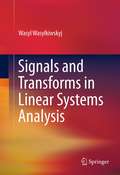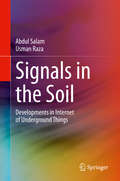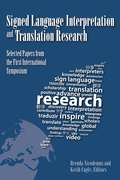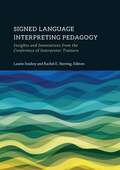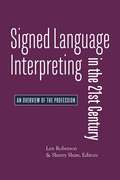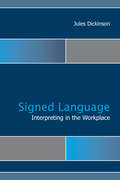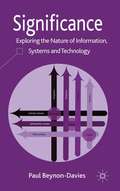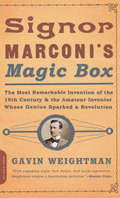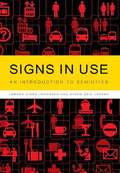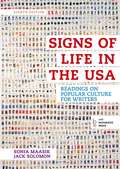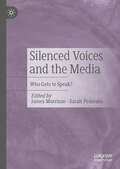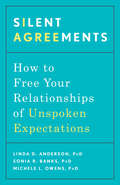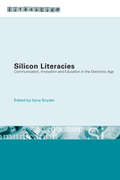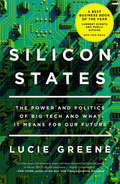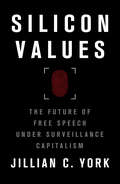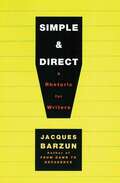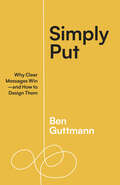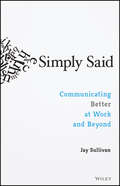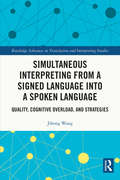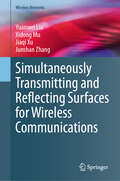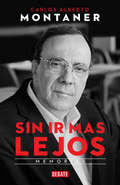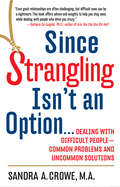- Table View
- List View
Signals and Transforms in Linear Systems Analysis
by Wasyl WasylkiwskyjSignals and Transforms in Linear Systems Analysis covers the subject of signals and transforms, particularly in the context of linear systems theory. Chapter 2 provides the theoretical background for the remainder of the text. Chapter 3 treats Fourier series and integrals. Particular attention is paid to convergence properties at step discontinuities. This includes the Gibbs phenomenon and its amelioration via the Fejer summation techniques. Special topics include modulation and analytic signal representation, Fourier transforms and analytic function theory, time-frequency analysis and frequency dispersion. Fundamentals of linear system theory for LTI analogue systems, with a brief account of time-varying systems, are covered in Chapter 4 . Discrete systems are covered in Chapters 6 and 7. The Laplace transform treatment in Chapter 5 relies heavily on analytic function theory as does Chapter 8 on Z -transforms. The necessary background on complex variables is provided in Appendix A. This book is intended to serve as a text on signals and transforms for a first year one semester graduate course, primarily for electrical engineers.
Signals in the Soil: Developments in Internet of Underground Things
by Abdul Salam Usman RazaThis book provides an in-depth coverage of the most recent developments in the field of wireless underground communications, from both theoretical and practical perspectives. The authors identify technical challenges and discuss recent results related to improvements in wireless underground communications and soil sensing in Internet of Underground Things (IOUT). The book covers both existing network technologies and those currently in development in three major areas of SitS: wireless underground communications, subsurface sensing, and antennas in the soil medium. The authors explore novel applications of Internet of Underground Things in digital agriculture and autonomous irrigation management domains. The book is relevant to wireless researchers, academics, students, and decision agriculture professionals. The contents of the book are arranged in a comprehensive and easily accessible format.Focuses on fundamental issues of wireless underground communication and subsurface sensing;Includes advanced treatment of IOUT custom applications of variable-rate technologies in the field of decision agriculture, and covers protocol design and wireless underground channel modeling;Provides a detailed set of path loss, antenna, and wireless underground channel measurements in various novel Signals in the Soil (SitS) testbed settings.
Signed Language Interpretation and Translation Research: Selected Papers from the First International Symposium
by Keith Cagle Brenda NicodemusThis volume brings together the best research presented at the first International Symposium on Signed Language Interpreting and Translation Research. Editors Brenda Nicodemus and Keith Cagle have gathered an international group of contributors who are recognized leaders in signed language interpreter education and research. The ten papers in Signed Language Interpretation and Translation Research cover a range of topics, including the need for Deaf perspectives in interpretation research, discourse strategies and techniques that are unique to video relay call settings, the benefits of using sociology as a lens for examining sign language interpreting work, translating university entrance exams from written Portuguese into Libras (Brazilian Sign Language), the linguistic choices interpreters make when interpreting ASL figurative language into English, the nature of designated interpreting, and grammatical ambiguity in trilingual VRS interpreting. The research findings and insights contained here will be invaluable to scholars, students, and practitioners.
Signed Language Interpreting Pedagogy: Insights and Innovations from the Conference of Interpreter Trainers (The Interpreter Education Series #13)
by Laurie Swabey Rachel E. HerringFor over forty years, the Conference of Interpreter Trainers has provided opportunities for advancing teaching and learning in interpreter education. This volume highlights fifteen seminal papers from past conference proceedings, along with newly written responses to the selected papers. Many of the new contributions are co-written by the author of the original paper and one or more emerging scholars, giving readers a historical lens on how the field of signed language interpreting pedagogy has evolved. The volume also calls attention to issues with which the field must urgently contend, such as implementing a Deaf-centric approach, multicultural interpreting curricula, the recruitment and retention of African American/Black students, and social justice. The contributors explore other important topics in interpreter education including ethics, Deaf translation, performance evaluation, consecutive and simultaneous interpreting, discourse analysis, critical thinking, curriculum sequencing, the social construction of learning, and mentoring. Through this collaborative approach featuring more than thirty scholars, Signed Language Interpreting Pedagogy presents a wealth of theoretical and practical information for interpreter educators and their students.
Signed Language Interpreting in the 21st Century: An Overview of the Profession
by Len Roberson Sherry ShawThis text provides interpreting students with a broad knowledge base that encompasses the latest research, addresses current trends and perspectives of the Deaf community, and promotes critical thinking and open dialogue about the working conditions, ethics, boundaries, and competencies needed by a highly qualified interpreter in various settings. This volume expands the resources available to aspiring interpreters, including Deaf interpreters, and incorporates the voices of renowned experts on topics relevant to today’s practitioners. Each chapter provides students with objectives, keywords, and discussion questions. The chapters convey clear information about topics that include credentialing, disposition and aptitude for becoming an interpreter, interpreting for people who are DeafBlind, and working within specialty settings, such as legal and healthcare. A key resource for interpreter certification test preparation, this text follows the interpreter’s ethical, practical, and professional development through a career of lifelong learning and service.
Signed Language Interpreting in the Workplace
by Jules DickinsonThe last forty years have seen a dramatic change in the nature of work, with deaf people increasingly moving into white collar or office-based professions. The rise of deaf professionals has led to employment opportunities for signed language interpreters across a variety of workplace settings, creating a unique set of challenges that require specialized strategies. Aspects such as social interaction between employees, the unwritten patterns and rules of workplace behavior, hierarchical structures, and the changing dynamics of deaf employee/interpreter relationships place constraints upon the interpreter’s role and interpreting performance. Jules Dickinson’s examination of interpreted workplace interactions is based on the only detailed, empirical study of this setting to date. Using practitioner responses and transcripts of real-life interpreted workplace interactions, Dickinson’s findings demonstrate the complexity of the interpreter’s role and responsibilities. The book concentrates on the ways in which signed language interpreters affect the interaction between deaf and hearing employees in team meetings by focusing on humor, small talk, and the collaborative floor. Signed Language Interpreting in the Workplace demonstrates that deaf employees require highly skilled professionals to enable them to integrate into the workplace on a level equal with their hearing peers. It also provides actionable insights for interpreters in workplace settings that will be a valuable resource for interpreting students, practitioners, interpreter trainers, and researchers.
Significance
by Paul Beynon-DaviesSigns are critically important in all forms of activity, including business, because they establish what it is to be human. Without signs we could not think, we could not communicate what we think and we could not ensure that we collaborate together in our work, home and leisure. The aim of this book is to explain how and why they are significant.
Signor Marconi's Magic Box: The Most Remarkable Invention Of The 19th Century & The Amateur Inventor Whose Genius Sparked A Revo
by Gavin WeightmanThe world at the turn of the twentieth century was in the throes of "Marconi-mania"-brought on by an incredible invention that no one could quite explain, and by a dapper and eccentric figure (who would one day win the newly minted Nobel Prize) at the center of it all. At a time when the telephone, telegraph, and electricity made the whole world wonder just what science would think of next, the startling answer had come in 1896 in the form of two mysterious wooden boxes containing a device Marconi had rigged up to transmit messages "through the ether. " It was the birth of the radio, and no scientist in Europe or America, not even Marconi himself, could at first explain how it worked. . . it just did. Here is a rich portrait of the man and his era-a captivating tale of British blowhards, American con artists, and Marconi himself-a character par excellence, who eventually winds up a virtual prisoner of his worldwide fame and fortune.
Signs in Use: An Introduction to Semiotics
by Jørgen Dines Johansen Svend Erik LarsenSigns in Use is an accessible introduction to the study of semiotics.All organisms, from bees to computer networks, create signs, communicate, and exchange information. The field of semiotics explores the ways in which we use these signs to make inferences about the nature of the world.Signs in Use cuts across different semiotic schools to introduce six basic concepts which present semiotics as a theory and a set of analytical tools: code, sign, discourse, action, text, and culture. Moving from the most simple to the most complex concept, the book gradually widens the semiotic perspective to show how and why semiotics works as it does.Each chapter covers a problem encountered in semiotics and explores the key concepts and relevant notions found in the various theories of semiotics. Chapters build gradually on knowledge gained, and can also be used as self-contained units for study when supported by the extensive glossary. The book is illustrated with numerous examples, from traffic systems to urban parks, and offers useful biographies of key twentieth-century semioticians.
Signs of Life in the U.S.A.: Readings on Popular Culture for Writers (Eighth Edition)
by Sonia Maasik Jack SolomonSigns of Life is written by a prominent semiotician and an experienced writing instructor, and it has been extensively updated to account for the rapid evolution of contemporary trends and student interests. It features insightful themes with provocative and current reading selections that ask students to think analytically about America’s popular culture: How has niche advertising been used to develop a highly detailed profile of your consumer habits? Why are Americans so transfixed by "bad guys"? Signs of Life bridges the transition to college writing by providing students with academic language to talk about the significance of our shared cultural experiences.
Silenced Voices and the Media: Who Gets to Speak?
by James Morrison Sarah PedersenThis edited collection delves into the multifaceted theme of 'Silenced Voices,' showcasing a diverse array of perspectives from scholars around the globe. From historical reflections to contemporary analyses, the book examines the complex dynamics of voice suppression and enablement across different media landscapes. Divided into four thematic sections, the chapters explore the challenges faced by marginalized and mainstream voices alike. From the portrayal of silenced narratives in the news media to the representation of underrepresented groups in cultural production, the collection spans a wide spectrum of issues. Authors employ varied methodological approaches to investigate the silencing of voices in the realms of politics, society, and professional media practices. Offering fresh insights and critical reflections, this volume serves as a timely contribution to ongoing debates surrounding freedom of expression, fake news, and the complexities of contemporary media environments.
Silent Agreements: How to Free Your Relationships of Unspoken Expectations
by Linda D. Anderson Sonia R. Banks Michele L. OwensSilent Agreements will help readers define the unspoken beliefs and expectations that might be causing dissatisfaction, unhappiness, and resentment in their relationships, giving them the tools to explore these agreements and work toward healthier communication with a partner, friend, boss, or family member.If you have relationships, you've likely been part of silent agreements. Silent agreements are the implicit "rules" of your relationships that arise from unspoken beliefs and expectations that both parties hold, stemming from your earliest experiences and reinforced as you mature. They can sound something like "The person who makes more money should pay for the dates," or "My boss doesn't offer me a raise, and he knows I won't ask for one." These agreements can hinder your relationships, remaining undiscussed due to fear, aversion to conflict, feelings of obligation, or guilt. Because expectations so rarely line up and neither person will address the issue, a silent agreement can cause unhappiness and resentment on both sides. Clinical psychologists Drs. Anderson, Banks, and Owens will help you explore your agreements and work towards healthier communication with a partner, friend, boss, or family member. In the process, you'll learn more about your own motivations and how to dismantle the the beliefs that don't serve you. With guidelines and advice on how to have productive conversations about sex, money, commitment, family, the workplace, and health, this book will help you lift the silence and resolve those land-mine issues before they do irreparable damage.
Silicon Earth
by John D. CresslerWe are in the swirling center of the most life-changing technological revolution the Earth has ever known. In only 60 years, an eye-blink of human history, a single technological invention has launched the proverbial thousand ships, producing the most sweeping and pervasive set of changes ever to wash over humankind; changes that are reshaping the very core of human existence, on a global scale, at a relentlessly accelerating pace. And we are just at the very beginning. Silicon Earth introduces readers with little or no background to the many marvels of microelectronics and nanotechnology, using easy, non-intimidating language, with an intuitive approach using minimal math. The general scientific and engineering underpinnings of microelectronics and nanotechnology are addressed, as well as how this new technological revolution is transforming a broad array of interdisciplinary fields, and civilization as a whole. Special "widget deconstruction" chapters address the inner workings of ubiquitous micro/nano-enabled pieces of technology such as cell phones, flash drives, GPS, DVDs, and digital cameras.
Silicon Literacies: Communication, Innovation and Education in the Electronic Age (Literacies)
by Ilana SnyderElectronic communication is radically altering literacy practices. Silicon Literacies unravels the key features of the new communication order to explore the social, cultural and educational impact of silicon literacy practices.Written by leading international scholars from a range of disciplines, the essays in this collection examine the implications of text produced on a keyboard, visible on a screen and transmitted through a global network of computers. The book covers topics as diverse as role-playing in computer games, the use of graphic symbols in on-screen texts and Internet degree programmes to reveal that being literate is to do with understanding how different modalities combine to create meaning.Recognizing that reading and writing are only part of what people have to learn to be literate, the contributors enhance our understanding of the ways in which the use of new technologies influence, shape and sometimes transform literacy practices.
Silicon States: The Power and Politics of Big Tech and What It Means for Our Future
by Lucie GreeneNamed a Best Book of the Year by Esquire Winner of the 800–CEO–READ Business Book Award in Current Events and Public Affairs In an era when faith in government and its institutions is quickly eroding, the businesses of Silicon Valley are stepping in to fill the gap. With outsize supplies of cash, talent, and ambition, a small group of corporations have been gradually seizing leadership—and consumer confidence—around the world. In Silicon States, renowned futurist and celebrated international think–tank leader Lucie Greene offers an unparalleled look at the players, promises, and potential problems of Big Tech. Through interviews with corporate leaders, influential venture capitalists, scholars, journalists, activists, and more, Greene explores the tension inherent in Silicon Valley's global influence. If these companies can invent a social network, how might they soon transform our political and health–care systems? If they can revolutionize the cell phone, what might they do for space travel, education, or the housing market? As Silicon Valley faces increased scrutiny over its mistreatment of women, cultural shortcomings, and its role in widespread Russian election interference, we are learning where its interests truly lie, and about the great power these companies wield over an unsuspecting citizenry. While the promise of technology is seductive, it is important to understand these corporations' possible impacts on our political and socioeconomic institutions. Greene emphasizes that before we hand our future over to a rarefied group of companies, we should examine the world they might build and confront its benefits, prejudices, and inherent flaws. Silicon States pushes us to ask if, ultimately, this is the future we really want.
Silicon Values: The Future of Free Speech Under Surveillance Capitalism
by Jillian C. YorkHow Google, Facebook and Amazon threaten our DemocracyWhat is the impact of surveillance capitalism on our right to free speech? The Internet once promised to be a place of extraordinary freedom beyond the control of money or politics, but today corporations and platforms exercise more control over our ability to access information and share knowledge to a greater extent than any state. From the online calls to arms in the thick of the Arab Spring to the contemporary front line of misinformation, Jillian York charts the war over our digital rights. She looks at both how the big corporations have become unaccountable censors, and the devastating impact it has had on those who have been censored.In Silicon Values, leading campaigner Jillian York, looks at how our rights have become increasingly undermined by the major corporations desire to harvest our personal data and turn it into profit. She also looks at how governments have used the same technology to monitor citizens and threatened our ability to communicate. As a result our daily lives, and private thoughts, are being policed in an unprecedented manner. Who decides the difference between political debate and hate speech? How does this impact on our identity, our ability to create communities and to protest? Who regulates the censors? In response to this threat to our democracy, York proposes a user-powered movement against the platforms that demands change and a new form of ownership over our own data.
Simple and Direct
by Jacques BarzunAfter a lifetime of writing and editing prose, Jacques Barzun has set down his view of the best ways to improve one's style. His discussions of diction, syntax, tone, meaning, composition, and revision guide the reader through the technique of making the written word clear and agreeable to read. <p><p>Exercises, model passages both literary and casual, and hundreds of amusing examples of usage gone wrong show how to choose the right path to self-expression in forceful and distinctive words.
Simplicity is Complex: Foundations of Cyber-Physical System Design
by Hermann KopetzThis book investigates the characteristics of simple versus complex systems, and what the properties of a cyber-physical system design are that contribute to an effective implementation and make the system understandable, simple to use, and easy to maintain. The targeted audience is engineers, managers and advanced students who are involved in the design of cyber-physical systems and are willing to spend some time outside the silo of their daily work in order to widen their background and appreciation for the pervasive problems of system complexity.In the past, design of a process-control system (now called cyber-physical systems) was more of an art than an engineering endeavor. The software technology of that time was concerned primarily with functional correctness and did not pay much attention to the temporal dimension of program execution, which is as important as functional correctness when a physical process must be controlled. In the ensuing years, many problems in the design of cyber-physical systems were simplified. But with an increase in the functional requirements and system size, the complexity problems have appeared again in a different disguise. A sound understanding of the complexity problem requires some insight in cognition, human problem solving, psychology, and parts of philosophy.This book presents the essence of the author’s thinking about complexity, accumulated over the past forty years.
Simply Put: Why Clear Messages Winand How to Design Them
by Ben GuttmannStop complicating everything! Create simple messages that are more powerful, more memorable, and win people over.Simply Put is a modern exploration of the simplicity principle for anybody who needs to sell stuff or persuade others. This book is a splash of cold water, designed to wake up entrepreneurs, C-suite executives, and marketing pros who have something they need to tell the world but just can't quite connect the dots. With this book, we're all better marketers.So why does simple win? And how do we get simple? The award-winning marketing entrepreneur behind New York Times best-selling authors and notable campaigns such as I Love NY provides answers and tools to simplify messages in this practical guide. From Yes We Can to Just Do It, regardless of if they're trying to get your dollars, your votes, or just your thoughts, effective messages share one thing they're simple. Being able to tell your story clearly and effectively is the winning skill for the next generation of entrepreneurs and leaders.
Simply Said: Communicating Better at Work and Beyond
by Jay SullivanMaster the art of communication to improve outcomes in any scenario Simply Said is the essential handbook for business communication. Do you ever feel as though your message hasn't gotten across? Do details get lost along the way? Have tense situations ever escalated unnecessarily? Do people buy into your ideas? It all comes down to communication. We all communicate, but few of us do it well. From tough presentations to everyday transactions, there is no scenario that cannot be improved with better communication skills. This book presents an all-encompassing guide to improving your communication, based on the Exec|Comm philosophy: we are all better communicators when we focus focus less on ourselves and more on other people. More than just a list of tips, this book connects skills with scenarios and purpose to help you hear and be heard. You'll learn the skills to deliver great presentations and clear and persuasive messages, handle difficult conversations, effectively manage, lead with authenticity and more, as you discover the secrets of true communication. Communication affects every interaction every day. Why not learn to do it well? This book provides comprehensive guidance toward getting your message across, and getting the results you want. Shift your focus from yourself to other people Build a reputation as a good listener Develop your written and oral communications for the greatest impact Inspire and influence others Communicate more effectively in any business or social situation Did that email come across as harsh? Did you offend someone unintentionally? Great communication skills give you the power to influence someone's thinking and guide them to where you need them to be. Simply Said teaches you the critical skills that make you more effective in business and in life.
Simulating Antiquity in Boys' Adventure Fiction: Maps and Ink Stains (Elements in Publishing and Book Culture)
by Thomas VrankenA genre that glorifies brutish masculinity and late Victorian imperialism, boys' 'lost world' adventure fiction has traditionally been studied for its politically problematic content. While attuned to these concerns, this Element approaches the genre from a different angle, viewing adventure fiction as not just a catalogue of texts but a corpus of books. Examining early editions of Treasure Island, King Solomon's Mines, and The Lost World, the Element argues that fin-de-siècle adventure fiction sought to resist the nineteenth-century industrialisation of book production from within. As the Element points out, the genre is filled with nostalgic simulations of material anachronisms – 'facsimiles' of fictional pre-modern paper, printing, and handwriting that re-humanise the otherwise alienating landscape of the modern book and modern literary production. The Element ends by exploring a subversive revival of lost world adventure fiction that emerged in response to ebooks at the beginning of the twenty-first century.
Simultaneous Interpreting from a Signed Language into a Spoken Language: Quality, Cognitive Overload, and Strategies (Routledge Advances in Translation and Interpreting Studies)
by Jihong WangThis book examines conference-level simultaneous interpreting from a signed language into a spoken language, drawing on Auslan (Australian Sign Language)-to-English simultaneous interpretation data to explore the skills, knowledge, strategies, and cognitive abilities needed for effective interpretations in this language direction. As simultaneous interpreting from a spoken language into a signed language is the widely accepted norm within the field of signed language interpreting, to date little has been written on simultaneous interpreting in the other language direction. In an attempt to bridge this gap, Wang conducts microanalysis of an experimental corpus of Auslan-to-English simultaneous interpretations in a mock conference setting to investigate different dimensions of quality assessment, interpreting strategies, cognitive load, and the interpreting process itself. The focus on conference-level simultaneous interpreting not only allows for insights into the impact of signed language variation on the signed-to-spoken language simultaneous interpreting process but also sheds light on the unique demands of conference settings such as the requirement of using a formal register. Acting as a bridge between spoken language interpreting studies and signed language interpreting studies and highlighting implications for future research on simultaneous interpreting of other language combinations (spoken and signed), this book will be of interest to scholars in translation and interpreting studies as well as active practitioners in these fields.
Simultaneously Transmitting and Reflecting Surfaces for Wireless Communications (Wireless Networks)
by Junshan Zhang Yuanwei Liu Xidong Mu Jiaqi XuThis book begins with discussing the fundamentals of Simultaneously Transmitting and Reflecting Surfaces (STARS) from the electromagnetic (EM) and communication perspectives. The basic signal and channel models for employing STARS in wireless communications is introduced as well. Then, the different categories and possible hardware implementation of STARS are highlighted. Next, the authors focus on attention to the STARS-aided wireless communications. The authors provide a comprehensive performance analysis of STARS with the outage probability, diversity gain and power scaling laws. Moreover, the operating protocols and corresponding beamforming design of STARS are discussed under different phase-shift models. As a further advance, the application of machine learning tools in STAR-aided wireless communications is introduced for addressing the beamforming design and resource allocation problems. The novel STARS-aided integrated sensing and communications (ISAC) in future wireless networks are also discussed with several case studies. Within this book, readers will find an extensive exploration of the STARS concept. The content encompasses a thorough survey of STARS research, covering principles, implementation, performance evaluation and applications. By presenting a comprehensive review of the STARS family, this book serves as a valuable resource for gaining insight into the complete pipeline of STARS research. Finally, the authors conclude the book by highlighting several future research directions for STARS. This book targets graduate, undergraduate, and postgraduate students as well as researchers working in wireless communications. Wireless communication engineers in industry and government will also want to purchase this book.
Sin ir más lejos
by Carlos Alberto Montaner#Llegó la hora de recapitular. Hay que ir haciendo las maletas. Desaparecer es una actividad ingrata que sólo se justifica porque es la única prueba irrefutable de que hemos vivido#. En estas página, el escritor y periodista cubano Carlos Alberto Montaner sobre cuanto ha visto y oído, lo que ha creido y lo que recuerda, pero advierte que habrá algunos pasajes involuntariamente inventados: #A veces, incluso, los sueños se mezclan con la realidad y es difícil saber dónde terminan unos y comienza la otra. Las memorias no son estudios históricos sino el reflejo de las percepciones y éstas se desdibujan o se transforman con el tiempo de manera inexorable#. Con estas memorias, que decidió comenzar a redactar en 2015, Montaner hablará sobre la Revolución Cubana, ocurrida durante su adolescencia y que moldeó su vida. Continuará con sus años de exilio, que comenzó a los 18 años y lo llevaron de Miami a Puerto Rico, de allí a España y nuevamente a Miami, siempre con un pie en un avión. #Utilizaré estos recuerdos para incursionar en el juicio histórico y político#. Pese a haber vivido fuera de Cuba las cuatro quintas partes de su vida, Montaner advierte que #no recuerdo un solo día en el que esa isla no hubiera estado presente en mí de alguna forma. Siempre ha existido una llamada, una noticia, un visitante, un artículo, un libro, una entrevista, una firma colectiva, una conversación, algo que me obligaba a recordar mi condición de exiliado y me retrotraía al centro del conflicto#. Al final el autor hace una relevación personal que dará mucho de qué hablar.
Since Strangling Isn't an Option: Dealing with Difficult People--Common Problems and Uncommon Solutions
by Sandra A. CroweFor those who feel like they are expending too much energy either engaging in conflict or desperately trying to avoid it, this refreshing, realistic guide provides accessible solutions. Readers will learn why dealing with a difficult person doesn't have to ruin their day, the habits that cause conflict, and the techniques that can turn things around. It also gives readers insight into their own power in shaping relationships, and specific advice for handling different personality types. There really is a better way!
